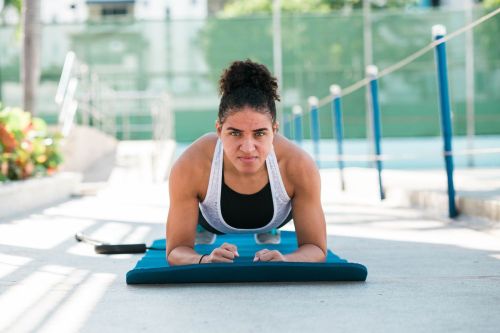How to keep stronger muscles from overcompensating for weaker ones in your workout
Keep your muscle and strength even and not overcompensate with stronger body parts for weaker ones, so that you can reap the benefits of your sweat sesh.

Workouts are great and all, but if done haphazardly, without full focus and proper posture, you might just find yourself injured or imbalanced. If that’s the case, your body might be overcompensating with stronger muscles and letting the weaker ones get off easy. But, is there a way to tell if your stronger muscles are overcompensating before a serious injury occurs? That’s exactly what we asked some of the industry’s top trainers. Check out their thoughts, below.
“Our bodies are incredibly resilient,” says certified trainer and Mindbody wellness manager Kate Ligler. “They will find ways to perform a movement or task even when our strength and mobility may not be sufficient—often compensating with muscles that aren’t built for the job.” The good news is that our bodies are excellent communicators, so if you’re looking for signs that your body is overcompensating, consider the four indicators below.
This is how to detect that your muscles are overcompensating
1. Chronic tightness or soreness: “If a muscle is working overtime, it’s going to be tight,” Ligler says. “Hamstrings commonly do the work of the glutes and are notoriously problematic.” To alleviate the issue, she says to properly activate your weaker muscles in the kinetic chain (AKA the overlapping body segments connected by a series of joints and muscles). Many muscles surround each of the main joints in the ankles, knees, spine, hips, and shoulders, and it’s important to focus on working all of them, rather than just those that are most prominent (like your abs, glutes, quads etc.).
2. Recurring injuries: You will spend less time rehabbing if you focus on the underlying overcompensation issues, Ligler explains. She notes that tendonitis, shin splints, and IT band issues are all indicators that something is amiss.
3. Lack of results: Are your triceps hiding no matter how hard you hit them at the gym? “Your shoulders and pecs are likely doing most of the work,” Ligler points out. “Focus on isolation exercises that limit movement from major surrounding joints (like the shoulder) to truly hone your work.”
4. Forever fatigued: “Does your body fatigue quickly while you are working out? Do you struggle to keep up with small, quick fire movements?” asks Y7 Studio instructor Caitlyn Casson. If the answer is yes, she says that you’re likely relying only on your major muscle groups for support. “Larger muscles—like the quads and glutes—tend to be stronger and therefore takeover in most movements.” To effectively support these larger, slow moving muscles, she recommends balancing out our exercise regimes with quick fire techniques. “My personal favorite quick fire exercises come from Pilates- and ballet-based workouts,” she points out.
Another cause of fatigue? Performing the same workout over and over. And when your muscles get tired, Flywheel instructor Kyle Axman says that it’s inevitable that your bigger muscle groups will try to pick up the slack. “The key is moderation and recovery,” he says. “Instead of riding every day for a week, sprinkle in some cross-training and yoga.”
How to prevent muscle overcompensation
With those four signs in mind, you might be wondering what else you can do to prevent overcompensation from happening in the first place. It all comes down to awareness and posture. “Strengthening smaller muscles requires a lot of attention to detail,” says SLT instructor Vanessa Padula. “They’re much harder to target than the larger muscles that surround them, because the larger muscles naturally pick up a lot of the work.”
To ensure that they don’t get neglected in favor of the larger, stronger muscles in the body, it’s important to pay attention to your form. “One of the most effective ways to tell if larger muscles are starting to overcompensate, is by double checking your form during every exercise,” Padula says. As your body begins to fatigue during an exercise, she says that your form may change and allow larger muscles to take over. So, while you might feel a tad odd (or even narcissistic) staring at yourself in the mirror during your entire workout: don’t. It’s actually really beneficial.
Keeping an eye on your form in the mirror allows you to make sure your body is aligned and in form to target specific muscles and prevent injuries. “Even if you don’t have a mirror right in front of you, a quick mental scan of your form and pausing to reset between every few reps can help improve posture and help to zone in on smaller muscles,” Padula points out.
At the end of the day, just listen to your body. Even if everything looks right in the mirror, if it doesn’t feel right, that could be a signal of stronger muscles taking over. “Mentally checking in and scanning your body to determine where you are feeling each exercise is key to specifically strengthening those hard-to-reach muscles,” Padula says. “If you are feeling it in the wrong place, a simple adjustment to your form could help correct that immediately.”
Didn’t believe that your alignment affects a whole lot more than your posture? Now that you’re convinced, it’s time to stretch that fascia for your best posture yet.
Sign Up for Our Daily Newsletter
Get all the latest in wellness, trends, food, fitness, beauty, and more delivered right to your inbox.
Got it, you've been added to our email list.










